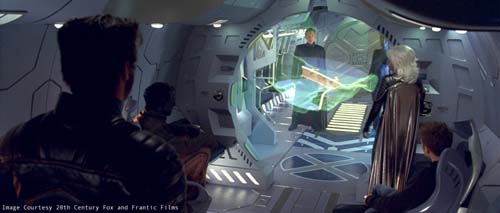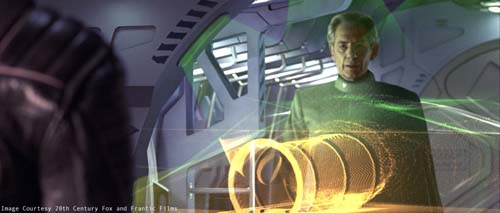Frantic Films, founded in 1997, has recently completed both pre-visualization and effects work on Fox ’s spring blockbuster X2.
X2 revolves around the epic battle between Humans and Mutant kind. X2 is the sequel to Fox’s highly successful take on the original Marvel Comic classic, X-Men . The action is kicked off with a brutal attack by an unknown assailant, who many suspect to be a Mutant with unthinkable powers. Frantic Films has provided us with a window into X2’s stunning visuals, as well as the key role that Digital Fusion played in completing all the shots with the utmost quality, while providing the necessary power and flexibility to meet the intense deadlines.
For X2 ,Frantic provided key pre-visualization design and replicated LIDAR-technology (Light Detection and Ranging), creating a photo-realistic holographic map for one of the VFX sequences. Frantic ’s work on X2 extended beyond pre-viz though, culminating in twenty-three post-effects shots.
Commenting on Fusion ’s pre-visualization application, and the benefits of the 2D environment to pre-viz, Darren Wall, 2D Supervisor and pre-viz art director for Frantic says, “DF allowed me to be a control freak. I got the 3D guys to turn out really simple geometric shapes, avoiding expensive volumetric renders and saving me the hassle of kicking elements back to 3D because the density was wrong, or the fall off too great – I could control all that in the comp.”
As for Frantic ’s effects shots, they used the look of the above mentioned LIDAR technology as inspiration for the creation of a hologram map pictured inside of the X-Jet, the goal was to recreate the look and feel of the LIDAR-technology in CG, generating a strikingly three-dimensional, photo-realistic LIDAR image – in this case, of Stryker’s Base, to illustrate a critical plot line in a story involving the character of Wolverine.

In the real world, a LIDAR box works by scanning the environment using laser technology. Wherever the laser hits a surface, the LIDAR hardware creates a dot in 3D space at the location where the hit-point is detected. This effectively results in the virtual re-creation of the environment in small points, which, if created with a high-resolution sampling rate, achieves the effect of smooth and instantly recognizable surfaces.

Beyond the creation of a LIDAR like image, the Frantic crew had to solve various problems to get the CG elements to seamlessly integrate into the live action plates.
Darren Wall further discusses one such problem using the last shot of the Hologram Map sequence as an example.
“The camera move had a tilt and pan both during a dolly in, with a rack focus. It was the rack focus that was really messing us up, because the blur was severe enough to obliterate any trackable landmarks. Our matchmover tried to 3D track it, our 3D lead tried to track it, and they got us into the ballpark, but it still wasn’t perfect. With the DF tracker, we could get superior tracks of different points around the frame, in foreground, midground and deep background to stabilize the shot, even with the focus pull. Then we could stabilize our slippery 3D elements, combine them with the stabilized plate and then re-introduce the original move.”
Fusion was also used throughout the Hologram map sequence for the seamless addition of mountainscape background plates to the windows of the X-Jet
Frantic also completed shots involving the re-creation of the eye-scanning system used by Patrick Stewart’s character, Professor Xavier, to enter Cerebro. Frantic 2D Compositor, Jason Booth explains the intricacies of this particular shot.
“We received this shot late into the production, and were able to turnaround several takes under tight deadlines, nailing the look VFX Supervisor Mike Fink and Director Bryan Singer were looking for. Using only a rudimentary shape built in 3D, Fusion helped define the final shape, color and particle density seen in the final shot. Utilizing the Luma Key and Chroma Key, both native tools in Fusion, we isolated the lights, darks and colors of Patrick Stewart’s face as the beam passed over his eye. The deform tool enabled us to contour the beam to Patrick Stewarts face, saving time by not having to model his head in 3D. The end result is a detailed interaction between the eye scanning beam and Patrick Stewart’s Face.”
(All Images Courtesy 20th Century Fox and Frantic Films.)
